With more than 500 active faults in the state of California, chances are you live in an area at risk for an earthquake.
While most earthquakes are small in magnitude and cause little or no damage, California experiences more than 100 quakes per day.
It is important to prepare for an earthquake now so recovery after the shaking stops can be as easy as possible.
MAKE A FAMILY EMERGENCY PLAN
In the event of an earthquake, it is important the entire family is aware of your emergency plan. Decide how you will communicate in an emergency.
Put together an emergency kit with essential items. It’s important to remember that this isn’t a go-bag, but a kit for staying-in-place. An earthquake can disrupt water, electricity, and phone services for several days. And don’t forget your pets! Make sure you have plenty of food available for them in case you can’t leave your home.
PREPARE YOURSELF FOR AN EARTHQUAKE

Give yourself vital seconds to prepare before any shaking starts. To receive earthquake warnings, download the MyShake App and ensure phone settings are adjusted to receive emergency alerts, including:
- MyShake App: Free smartphone app that provides iPhone and Android users with audio and visual warnings [magnitude 4.5 or higher and Modified Mercalli Intensity III (weak) shaking]. Available in the Apple App and Google Play stores;
- Android Earthquake Alerts: Android phones with updated operating systems are automatically subscribed to Android Earthquake Alerts, which uses the same technology as the MyShake App; and
- Wireless Emergency Alerts (WEAs): No-cost text messages for emergency situations [magnitude 5.0 or higher and Modified Mercalli Intensity IV (light) shaking].
You can also prepare your home before the next earthquake strikes. Identify the following possible home hazards and properly secure them:
- Tall, heavy furniture that can fall, such as bookcases, china cabinets or wall units.
- Stoves and appliances that might move during shaking and rupture gas or electrical lines
- Heavy picture frames or mirrors hanging over a bed
- Breakables or heavy objects that are kept on high shelves
Don’t forget to place heavy objects away from doors and escape routes.
WHEN YOU FEEL SHAKING

DROP: Wherever you are, drop to your hands and knees. This position helps to keep you from being knocked down. It also allows you to crawl to shelter.
COVER: Use one arm and hand to cover your head and neck. If there is a sturdy table or desk nearby, crawl under it for shelter. If no shelter is available, crawl next to an interior wall away from windows.
HOLD ON: If you’re under shelter, hold onto it with one hand. If not under shelter, use both arms and hands to cover your head and neck. When using a cane, walker, or wheelchair, be sure to still cover your head and neck with your arms and hands.
If you’re in bed when the shaking starts, cover your head and neck with pillows. If you’re home, don’t go outside. If you are outside, move away from buildings that may collapse. Stay in an open area away from trees and power lines.
CHECK FOR INJURIES AND DAMAGES
Once the earthquake is over and it feels safe to move around, check your household for possible injuries. Start first aid or seek immediate medical attention.
Check your property by examining electrical wires, appliances, utilities, and chimneys for damages.
Additional shakes – or aftershocks – may happen after an earthquake, be prepared to get back under shelter if necessary.
For more information on becoming earthquake prepared, visit: https://www.earthquakeauthority.com/California-Earthquake-Risk/Personal-Preparedness

